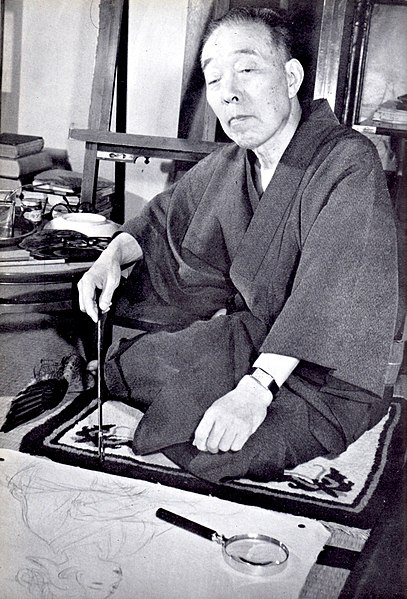| |
KABURAGI Kiyokata(1886-1972)Biography |
|
| KABURAKI Kiyokata (1953) in
his studio (Photographed by Shigeru Tamura "Hundred People of Contemporary Japan" Bungei Haruaki Shinsha, published in 1953) |
Artist – KABURAKI Kiyokata (鏑木
清方) was born on August 31 in the Kanda district of Tokyo as
KABURAKI Ken'ichi (鏑木 健一). He was the third son of the editor
Jōno Saigiku (条野 採菊). The family was friends with many painters,
writers and actors, and its neighbor was the wood cutter Utagawa
HIROSHIGE III (1866–1908). He was a well known nihonga and ukiyo-e
artist.
At the age of 13, Ken'ichi was sent to become a pupil of the ukiyo-e artists TOSHIKATA Mizuno (1866- 1908) and later with the ukiyo-e artist YOSHITOSHI Taiso (1839 - 1892). KABURAKI started his career as an illustrator in newspapers. His first job was as an illustrator for Yamato Shinbun, a Tokyo newspaper founded by his father. KABURAKI gained fame as the creator of ukiyo-e. In 1901, he cofounded the Ugokai (烏合会), an art group dedicated to reviving and popularizing bijin-ga (images of beautiful women). In 1907 the government established the 'Fine Arts Reviewing Committee', now 'Japanese Acadamy of Arts', with its famous most often annual BUNTEN exhibitions. In 1915, he won first prize at the 9th Bunten with his work Murasame. In 1917 he cofounded "Kinrei-sha " (Golden Bell), another artist's group which promoted artistic freedom and personal expression, one of the forerunners of shin hanga.
He became a member of the restructured 'Imperial
Academy of Arts' (Teikoku Bijutsu-in) in 1929. KABURAKI was even
appointed to the Art Committee of the Imperial Household, and
received the official position of court painter in 1944. In 1954
he was awarded the Emperial Order of Culture.
Three of Kaburaki's works have been selected as the subject of commemorative postage stamps by the Japanese Postal Service. The latest one is the print 'First Easterly Winds", one of his last works.
Personal life - He was born into an affluent and literate family. His father was a playwright and founder, editor-in-chief of the daily Tōkyō Nichi-nichi Shimbun (now Mainichi Shimbun). When he was sixteen, his father went bankrupt and the family had to sell their home, one of the reasons for using the family name of his mother. During the firebombing of Tokyo in World War II, his home was burnt down, and he relocated to Kamakura, Kanagawa Prefecture, where he lived until his death on March 2 at the age of 93. His grave is at the Yanaka Cemetery in Tokyo. His house in Kamakura had been transformed into the Kaburagi Kiyokata Memorial Museum, displaying many of his works, and preserving his studio (cf. the picture above).
Aliases - Throughout his entire life he used his legal name 'KABURAKI Kiyokata' as 'gō' (ごう / 号, art-name) with 'KABURAKI' as the family name of his mother.
Disciples - KABURAKI trained lots of students. His school became a recruiting center for many artists for the well known editor and print shop owner WATANABE Shōzaburō (渡辺 庄三郎), his printshop becoming the epitome of shin hanga. KABURAKI's most notable students were Kawase Hasui, Itō Shinsui, Shiro Kasamasu, Yamakawa Shūhō, Torii Kotondo and Terashima Shimei.
Copyright 2008 ff: Hans P. Boehme